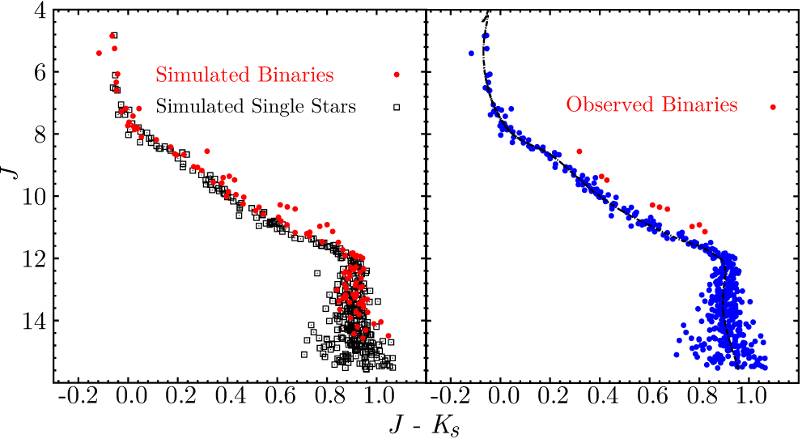| EPoS Contribution |
|
The binary fraction of Alpha Persei open cluster
Najmeh Sheikhi IASBS, Delijan, IR | |
| We have obtained membership probabilities of stars within a field of 3.3 deg from the centre of the Alpha Persei open cluster using proper motions and photometry from the PPMXL and WISE catalogues. We have identified 810 possible stellar members of Alpha Persei. From an examination of the high-quality colour-magnitude data of the cluster and performing a series of Monte Carlo simulations we obtained a binary fraction of fbin = 34±12 per cent for stars with 0.70 < m/Msol < 4.68. This is significantly larger than the observed binary fraction, indicating that this open cluster contains a large population of unresolved binaries. Finally, we corrected the mass-function slopes for the effect of unresolved binaries. | |
 | |
| Caption: (Left) Synthetic CMDs of simulated binaries (red filled circles) and single stars (black open squares) for a true binary fraction of 23 per cent over the whole mass range (0.1 < m/Msol < 4.68). The scatter of single stars is due to the added photometric errors which resemble actual photometric errors in PPMXL. (Right) The detected binaries (red filled circles) as well as single stars (blue filled circles) after applying the blind photometric test on the simulated data . As it can be seen, many of the binaries have been identified as single stars. The observed binary fraction is ~6 per cent. The PARSEC isochrone which is used in the blind photometric test, is shown by the black solid line. | |
| Collaborators: M. Hasheminia, IASBS, IR P. Khalaj, UQ, AU H. Haghi, IASBS, IR A. H. Zonoozi, IASBS, IR H. Baumgardt, UQ, AU |
Key publication
Suggested Session: Cluster Formation |

